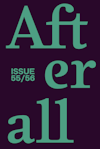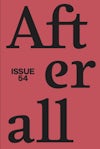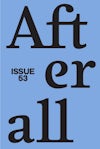
Issue 36
Summer 2014
Issue 36 features artists and artistic collectives that question the borders of the art world or exploit other possibilities within it, and asks how, within a homogenising art world, one can find a ‘without’ or a productive point of difference.
Editors: Melissa Gronlund, Anders Kreuger, Pablo Lafuente, Stephanie Smith, Nuria Enguita Mayo, Helena Vilalta, Louise O’Hare.
Founding editors: Charles Esche, Mark Lewis.
Table of contents
Foreword
Contextual Essays
- Brothers in Arms: Laboratoire AGIT’art and Tenq in Dakar in the 1990s – Clémentine Deliss
- The Artist as Double Agent – Zachary Cahill & Philip von Zweck
Artists
Enquiry on the/our outside
- Inhuman Polyphony in the Theatre of Madness – Peter Pál Pelbart
- Images that Haunt Us – Muriel Combes
K.P. Krishnakumar
- Midnight Dreams: The Tragedy of a Lone Revolutionary – Anita Dube
- Mutable Bodies: K.P. Krishnakumar and the Radical Association – Shanay Jhaveri
Nilbar Güres
- Visiting the Viewpoints of Others: On the Camouflaged Portraits of Nilbar Güres – Mihnea Mircan
- Cloth People from Outer Space: Nilbar Güres’s Dialectics of Identity – Lara Fresko
Panamarenko
- Panamarenko: A Plea to Broaden Art – Jeremy Millar
- Panamarenko: Love and Rockets – Jeremy Millar
Events, Works, Exhibitions
- Gendered Transformations: Carla Zaccagnini’s ‘Elements of Beauty’ – Emma Hedditch
- Not Quite Shame: Embarrassment and Andrea Büttner’s ‘Engel der Geschichte’ – Louise O’Hare
Foreword
Written by Melissa Gronlund & Helen Vilalta
What we realise, when the voice is missing, is that the organ persists, and its modulated sounds prove that the quivering vocal chords are actually still there.
But we also realise something else — that in the place of the instrument deserted by usage, another one emerges, which, curiously, is not destined to take over from the one no longer in use.
Now, with this instrument, which we are unable to play, we can ask ourselves if it is not the existence of this instrument itself that prevented the — autistic — individual from having a voice; so much so that the autistic being wouldn’t be the one lacking something; he would be equipped with something, rather, more. […]
They will say that it’s a shame if I rely on the fate of those who are strangers — but stranger to whom? To us? Rather, strangers to language, which then becomes the homeland of mankind. — Fernand Deligny 1
Having taught at a psychiatric hospital in Armentières in northern France before the outbreak of World War II, and later advocating for the ‘free’, non-institutional care of troubled youth, at the end of the 1960s the poet and pedagogue Fernand Deligny set up a network of temporary homes for autistic children in the Cévennes, a mountainous region in the south. The initiative emerged from the ashes of La Grande Cordée, the innovative, nationwide effort to re-educate so-called difficult teenagers; through that organisation, Deligny questioned both psychiatric and moral approaches to those on the periphery of society, and specifically, as he put it, the ‘youth that had fled to “the margins” and which society wished to bring back to normal life’. 2 As modest in scale as it was ambitious in scope, the experiment in the Cévennes went a step further by creating a living environment modelled after the autistic child’s way of being in the world, notably his or her withdrawal from language and social interaction more generally. In this network of farmhouses, therapists were replaced by untrained social workers and psychiatric confinement by life out in the open. Verbal communication was dispensed with and visual tools such as maps, photographs and films were used to interpret the children’s gestures and wanderings. At stake in this experience of communal living was not the attempt to educate the children or integrate them into ‘normal’ life, but, rather, to facilitate the conditions for a form of personal existence that refuses to adjust to what are, to a non-autistic sensibility, standard modes of perceiving, acting or communicating. Crucially, Deligny’s writings and films show how the de-pathologisation of autism within the network involved a broadening
of the spectrum of subjective life — a sea change in the attitude towards neurodiversity
that today resonates strongly in the autism rights movement. 3
If we bring up Deligny’s experiment here, it is not only because many of the artistic practices convened in this issue query the borders between sanity and madness, normality and marginality. More importantly, the way in which Deligny’s work with so-called marginal children called into question our very understanding of human subjectivity parallels how the practices discussed in these pages contest the geographical and conceptual map of the art system from its outside, as it were. His acute and unprejudiced observation of the children’s inner life brings to mind Andrea Büttner’s historically laden photographs of boys with mental disabilities appreciating art — themselves awkward to see or judge by aesthetic criteria — while his critique of the misrepresentation of difference as a lack with regards to autism resonates with Enquête sure le/notre dehors (Enquiry on the/our outside). Initiated by Alejandra Riera in 2007, this ongoing project explores what constitutes the borders of our society — what we relegate, for example, to the peripheries of city centres or outside of sanity. Like the farmhouse network in the Cévennes, it is motivated by an attempt to live together: to produce the conditions for a shared experience, sometimes recorded via ‘film-documents’, ‘partial views’ and written accounts that defy a sense of totality or closure. Riera’s consistent refusal of authorship over these collective experiences, and her resistance to formatting them according to the customary categories and modes of presentation of artistic practice, rubs time and again against the conventions of the art world (including the structure by which we organise the contents of this journal, according to which this project has been included under the ‘Artists’ rubric). In their discussion of the actual experience of living and working in the art world, Zachary Cahill and Philip von Zweck address how artists — whom they dub ‘double agents’ — live between structures. Already occupying a comfortable position in contemporary art history, Panamarenko defied the parameters within which the art world operates when he decided to retire from art-making in 2005. As Hans Theys reminds us, working mostly in the solitude of his studio in Antwerp, Panamarenko has relied on another sense of lived experience: the systematic querying of authoritative forms of knowledge through the building of impossible machines.
Purchase
The publication is available for purchase. If you would like specific articles only, it is also available individually and to be downloaded as PDFs.
Purchase full publication
Buy via University of Chicago Press
Buy via Central Books
Purchase individual articles
Buy via University of Chicago Press




